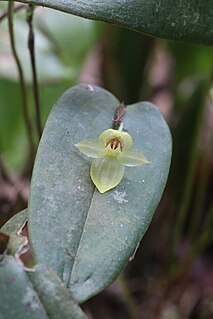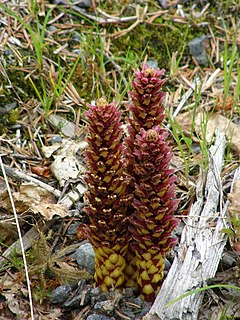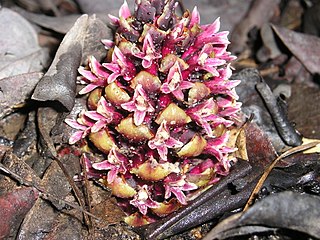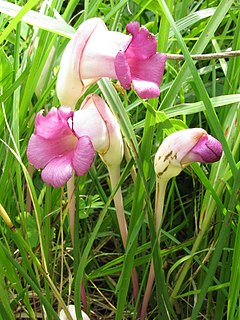
Alder is the common name of a genus of flowering plants, Alnus, belonging to the birch family Betulaceae. The genus comprises about 35 species of monoecious trees and shrubs, a few reaching a large size, distributed throughout the north temperate zone with a few species extending into Central America, as well as the northern and southern Andes.

Royal Botanic Gardens, Kew, is a non-departmental public body in the United Kingdom sponsored by the Department for Environment, Food and Rural Affairs. An internationally important botanical research and education institution, it employs 1,100 staff. Its board of trustees is chaired by Dame Amelia Fawcett.

Pleurothallis is a genus of orchids commonly called bonnet orchids. The genus name is derived from the Greek word pleurothallos, meaning "riblike branches". This refers to the rib-like stems of many species. The genus is often abbreviated as "Pths" in horticultural trade.

Goldenrod is a common name for many species of flowering plants in the sunflower family, Asteraceae, commonly in reference to the genus Solidago.

Cytisus is a genus of flowering plants in the family Fabaceae, native to open sites in Europe, western Asia and North Africa. It belongs to the subfamily Faboideae, and is one of several genera in the tribe Genisteae which are commonly called brooms. They are shrubs producing masses of brightly coloured, pea-like flowers, often highly fragrant. Members of the segregate genera, Calicotome, Chamaecytisus, and Lembotropis are sometimes included in Cytisus.

Clintonia is a genus of flowering plants in the lily family Liliaceae. Plants of the genus are distributed across the temperate regions of North America and eastern Asia, in the mesic understory of deciduous or coniferous forests. The genus, first described by Constantine Samuel Rafinesque in 1818, was named for DeWitt Clinton (1769–1828), a naturalist and politician from the U.S. state of New York. For this reason, plants of the genus are commonly known as Clinton's lily. The common name bluebead refer to the distinctive fruit of members of the genus. Since fruit color varies somewhat across species, the common name bead lily is used as well.

Bartonia is a genus of the gentian family, tribe Gentianeae, subtribe Swertiinae. Members of this genus are called screwstems. Bartonia was also the name of a genus in the Loasaceae family, but those species are now generally classified under the genus Mentzelia.

Habenaria, commonly called rein orchids or bog orchids, is a widely distributed genus of orchids in the tribe Orchideae. About 880 species of Habenaria have been formally described. They are native to every continent except Antarctica, growing in both tropical and subtropical zones.

Boschniakia is a genus of parasitic plants in the family Orobanchaceae. They are known commonly as groundcones and they are native to western North America and extreme northeastern Asia. Some taxonomists consider Boschniakia to be three separate genera: Boschniakia, Kopsiopsis, and Xylanche. When the genus is split, only a single species remains: Boschniakia rossica, the northern groundcone.

Kopsiopsis hookeri is a species of parasitic plant in the family Orobanchaceae known by as Vancouver groundcone or small groundcone.

Kopsiopsis strobilacea, the California groundcone, is a species of parasitic plant in the family Orobanchaceae. It is native to California and southern Oregon, where it grows in wooded areas and chaparral. It is a parasite of manzanitas and madrones, which it parasitizes by penetrating them with haustoria to tap nutrients. The groundcone is visible aboveground as a dark purplish or reddish to brown inflorescence up to 18 cm (7.1 in) long. Pale-margined purple flowers emerge from between the overlapping bracts.
The World Checklist of Selected Plant Families is an "international collaborative programme that provides the latest peer reviewed and published opinions on the accepted scientific names and synonyms of selected plant families." Maintained by the Royal Botanic Gardens, Kew, it is available online, allowing searches for the names of families, genera and species, as well as the ability to create checklists.

World Flora Online is an Internet-based compendium of the world’s plant species.

Protea namaquana, also known as the Kamiesberg sugarbush, is a flowering plant which belongs to the genus Protea. The plant is endemic to the southwestern Cape Region of South Africa, in particular the Kamiesberg mountains of Namaqualand in the Northern Cape province. The species has a worldwide distribution of only 18 km2. It is regarded as critically endangered. In the Afrikaans language it has the vernacular name is Kamiesbergsuikerbos.

Aeginetia is a genus of plants in the broomrape family Orobanchaceae, native mostly to tropical Asia.

Protea lorifolia, in English called the strap-leaved sugarbush, strap-leaved protea or strap-leaf sugarbush is a flowering shrub which belongs to the genus Protea.

Protea madiensis, commonly known as the tall woodland sugarbush, is a flowering shrub which belongs to the genus Protea. It is native to the montane grasslands of Sub-Saharan Africa.

Protea wentzeliana, also known as Wentzel's sugarbush, is a shrub belonging to the genus Protea.
Casselia is a small genus of flowering plants in the verbena family (Verbenaceae) first named in 1823. Plants in the genus Casselia are native to South America.
Zygoruellia richardii is a species of flowering plant in the family Acanthaceae. It is endemic to Madagascar. The monotypic genus and species were first formally named in 1890 by French botanist Henri Ernest Baillon. It is the only species in the genus Zygoruellia.

















